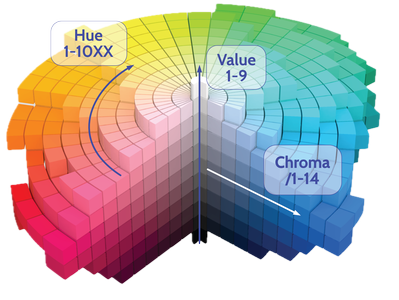Instructions
This application displays the colors and spectral reflectivity data of the color samples found in Munsell Color books. For more background on Albert H. Munsell, his color books, and, most importantly, his color order system, see the Munsell Color System section below.
The plots shown are derived from measurements done by the University of Eastern Finland UEF and by Robin Myers, shared through his spectral library collection at Chromaxion. They can be used freely for personal, scientific, and educational purposes and redistributed only with attribution to their respective sources. Data from these sites were converted to spectral JSON files, the applications on this site.
Output
At start-up, the spectral composition of the sample with the highest chroma value of a Munsell Color Book page is shown, which is the 5R5/14 sample, a Burgundy red color. Its name, a circular color sample, three sets of chromaticity values, and spectral distribution are shown above a color patch selection box on the web page. The chromaticity values displayed here are the CAM16 UCS Ja’b’ values, using the CIE2015 10° standard observer, and the OKLCH lightness, chroma, and hue values and sRGB hex value using the CIE 1931 2° standard observer. For the most accurate colorimetric perception representation and color matching, use the CAM16 values; in digital applications, use the OKLCH or the sRGB hex values, preferably in that order.
Color Book Selection
Below the plot is the color patch selection area. This app has spectral data measured using different spectrometers and from different color books. On start-up, the data, as measured by the University of Eastern Finland, is shown using a Munsell Matte Color Book published in xxx, identified by the label UEF/Matte. The following color book collections are available:
- The University of Eastern Finland Collections, with the labels
- UEF/Matte
- UEF/Gloss
- and the Robin Myers — Chromaxion Collection:
- Chromaxion/Matte
- Chromaxion/Soil
The measurements are done on the actual samples of a colorbook, which can vary due to production tolerances and aging. Also, different instruments were used for the measurements.
Hue Selection
The Munsell color book typically contains forty pages, each containing samples with the same Hue. They are identified by a number, with a value of 1, 2.5, 5, 7.5, or 10, and an abbreviation of the color group with R for Red, YR for Yellow-Red, Y for Yellow, GY for Yellow-Green, G for Green, BG for Blue-Green, B for Blue, PB for Purple-Blue, P for Purple, and, finally, RP for Red-Purple. Select a page from this online color book with the second tab. The first page shown is 5R with a collection of red colors.
The samples within a page are ordered by Chroma value on the horizontal axis and Munsell Value (lightness) on the vertical axis. The Munsell value is a number between 1 and 10, placed directly after the Hue value, and the Chroma value is the value after the forward-slash separator. In the Munsell Color System, the Chroma value is unbounded at the high end, but here you’ll find maximum values of 14.
Access Spectral Data
The spectral data can be copied to your device’s clipboard by clicking the spectral plot area. A regular click will copy the data as two columns of values, with wavelengths, in nanometer units, in the first column and spectral values in the second column. The values can be directly pasted into a spreadsheet if you want to do calculations yourself.
Spectral values are normalized to a peak value of 100.00 and are given with a three-decimal precision. Holding down the “shift”-key while clicking the spectral area will copy a single column of spectral data over a range from 380 to 780 nanometers, with a step size of 1 nanometer, resulting in a total of 401 copied values.
Troubleshooting
You must be online to use this app, as the spectral data are fetched from the website when selected. Please check your internet connection if you don’t see any spectral plot or sources in the list.
The site uses JavaScript, as many web apps do nowadays, but if you have disabled JavaScript support for this site, you need to enable it to use its functionality.
